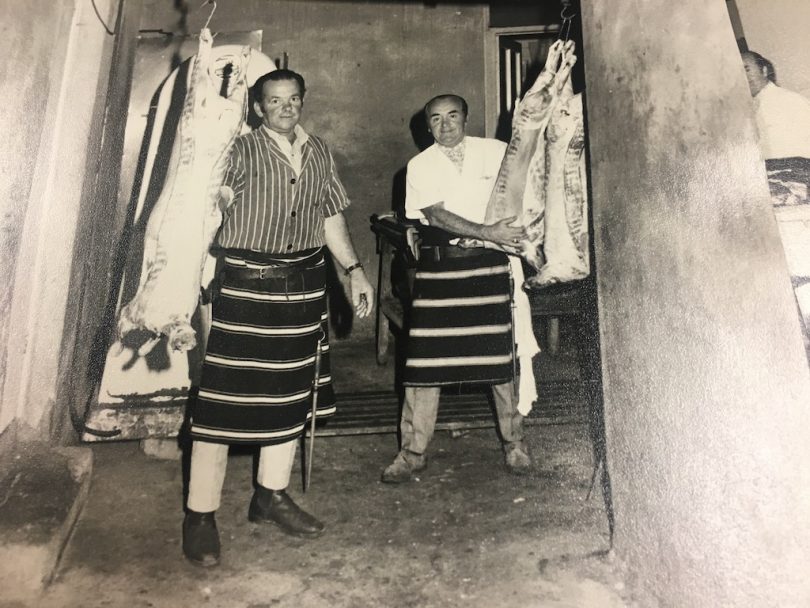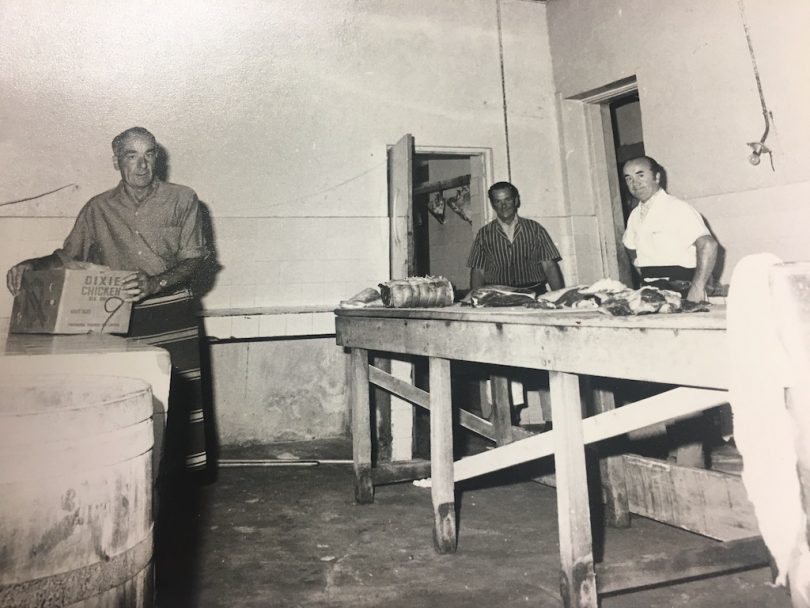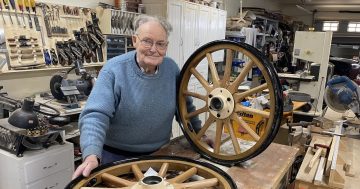
In retirement from the butcher’s trade, Roger Doughty has returned to his love of carpentry and turns out work that shows his craftsmanship. Photo: John Thistleton.
Years ago, cunning thieves followed the show circuit in southern NSW, blowing open safes and strongrooms along the way. They blew up a safe at Cooma and, in the dead of night, blew open a safe door inside a Goulburn butchery.
The annual shows helped the thieves’ anonymity because locals took no notice of strangers like them in town. On the Monday night following the Goulburn Show in March 1967, the burglars struck inside Doughty’s Butchery office. They had been practising with explosives in the bush, where police later discovered safes blown apart.
Their nitroglycerin charge inside Doughty’s shop was loud and devastating. The blast in the butcher shop on the corner of Clinton and Cowper Street woke neighbours in the old Australian Arms Hotel, including someone responsible for Doughty’s two, gas-heated 120-gallon coppers used for cooking.
“The young kid who worked for us, Smithy, lived three or four doors up,” Roger Doughty said. “He heard the noise and got out of bed and thought: ‘no, I did turn those coppers off properly!’ and went back to bed. Thank heavens, because the thieves would have still been there when he got there.”
The robbers’ appalling choice for muffling the explosion was a heavy lump of mincemeat from the butcher’s fridge. This they wrapped in a sheet used to line delivery van floors. Fragments of meat splattered over the walls, floor and ceiling.
Roger’s father, Allan, discovered the robbery at about 7 am and called the police. He then rang Roger who was managing the Blue Hills butcher shop in Combermere Street, asking him to bring down some change as the main shop had been cleaned out of coins.
Roger’s mother Gwen hadn’t banked since the previous Thursday, leaving three days’ worth of trading in the safe and a week’s takings from Blue Hills. So the thieves made off with more than $2000 in cash, a hefty haul given wages in those days were about $36 a week.
Jean Coogan, who had previously worked at the butcher shop, found the calico banking bag and all the cheques in her Victoria Avenue front yard. Evidently, the thieves, who were never caught, had been parked in front of her place, took out the cash and tossed the rest over her front fence.

Butchers Charlie Waterton and Allen’ Jockey’ Rudd with lamb carcasses at the Clinton Street butcher shop. Photo: Lionel Hart, Doughty family collection.
Despite the robbery, Doughty’s Butchery continued to flourish. A former shearer who delivered meat on a motorbike and sidecar, Allen had become a slaughterman for wholesalers Murrays before opening as a butcher.
Roger, on the other hand, was more interested in carpentry. At 14, he left school and became builder Arthur Grubb’s apprentice, then worked for builders including Bob Thwaite before going out on his own. Owed money, he accepted his father’s offer of two days a week work delivering meat and became more and more involved in butchery.
Doughty’s had three shops in the peak years: at Blue Hills where Roger started in 1965, on the corner of Clinton and Cowper, and in Sloane Street (Windscreens O’Brien today). They later closed the Sloane Street shop and relocated to Auburn Street, opposite the Goulburn Plaza where Bill Murray had been trading.
“When I first started in Clinton Street, there were 25 of us in the one shop,” Roger said. “Six girls, one was in the office, the others were pre-packers. We were pre-packing meat for S R Butles and Charles Rogers.” They also delivered to clients in the ACT, including Parliament House.
They were eventually excluded from Canberra. Meat had to be killed at Queanbeyan Abattoir and the territory’s butchers could only come from Canberra, Roger said.
“Yet they came down here, a couple had a go at taking our client Kenmore Hospital off us, which they did for a few months. One chap got two months into the contract and went belly up. Well, we had to take over again. One of them took St Pat’s boarding college. They were big orders then.
“The amount of meat we went through was incredible. The Clinton Street shop had a turnover (before decimal currency in 1966) of well in excess of a million pounds a year,” he said.

Bill Bush, Charlie Waterson and Allen’ Jockey’ Rudd in the butcher shop. Photo: Lionel Hart, Doughty family collection.
Roger learned to process and smoke bacon. Later he expanded with a second-hand oven he bought for $13,000.
“I could do 30 legs of ham at a time and probably 150 chickens.” Whether smoking trout, venison, skinned eels, wild pigs or kangaroos, his repertoire was hungrily sought by restaurants, schools, Japanese tourists and numerous, grateful families.
The builder had become a sought-after butcher.














